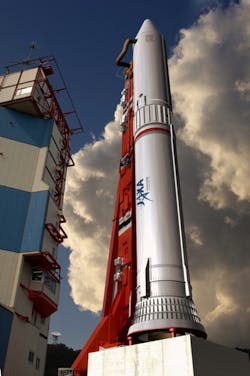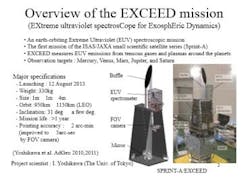Japanese rocket to use extreme UV spectroscopy to determine why some planets lose gases
Japan’s newest rocket, Epsilon, will be equipped with the world’s firsttelescope designed specifically to study planets from afar. The Japanese Aerospace Exploration Agency’s (JAXA) Spectroscopic Planet Observatory for Recognition of Interaction of Atmosphere, or Sprint-A, will look at Venus and Mars to determine why some planets lose their atmospheres while others manage to keep them.
The rocket was designed to be a smaller, less expensive (it costs about $38 million per launch) method to deployingsatellites into space. This particular mission was scheduled to launch today, August 27, but was cancelled because an automatic stop alarm was issued as an attitude abnormality was detected 19 seconds before the planned lift-off at 1:45 p.m. local time, according to Space.com.
When Epsilon does launch, however, it will deploy Sprint-A into low Earth orbit where it will observe Venus and Mars, as well as Mercury, Jupiter, and Saturn, usingcameras and sensors that record extreme ultraviolet light (EUV), according to NewScientist. EUV is a range of light suitable for observing planetary atmospheres due to the fact that extreme UV from the sun gets bent at the boundary where a planet’s atmosphere meets space, and the way it redirects can reveal the atmospheric composition, according to Shujiro Sawai of JAXA.
"[But] extreme UV radiation coming from space is absorbed by the Earth's atmosphere, so it is not observable from the ground," said Sawai. "Very little outer space observation with extreme UV has been done, so scientists are expecting new discoveries that no one has ever imagined before."
The extreme ultraviolent telescope on the Sprint-A is comprised of an EUV spectrometer, afield of view camera, a buffle, and a primary mirror, according to a research paper on the development of the extreme ultraviolet spectrometer:
In addition, it features a wavelength range of 55-145 nm with a spectral resolution of 0.4 – 1.0 nm. The spectrograph slits have a field of view of 400 x 140 arc-seconds (maximum) and the optics of the instrument include a primary mirror with a diameter of 20cm, a laminar-type grating, and an EUV detector that uses microchannel plates. The surfaces of the primary mirror and the grating are coated with chemical vapor deposition silicon carbide.
The research and results that JAXA hopes to obtain will in turn help exoplanet hunters to determine which planets may have atmospheres that could support life.
View theNewScientist article.
View more information on JAXA’s Sprint-A.
View more information on JAXA’s Epsilon rocket.
Also check out:
Subaru Telescope camera captures brilliant images of Andromeda Galaxy
Spitzer Space Telescope's images of gas emission from Comet ISON
NASA releases image of Saturn's view of Earth
Share your vision-related news by contactingJames Carroll, Senior Web Editor, Vision Systems Design
To receive news like this in your inbox,click here.
Join ourLinkedIn group | Like us on Facebook | Follow us on Twitter | Check us out on Google +
About the Author

James Carroll
Former VSD Editor James Carroll joined the team 2013. Carroll covered machine vision and imaging from numerous angles, including application stories, industry news, market updates, and new products. In addition to writing and editing articles, Carroll managed the Innovators Awards program and webcasts.

